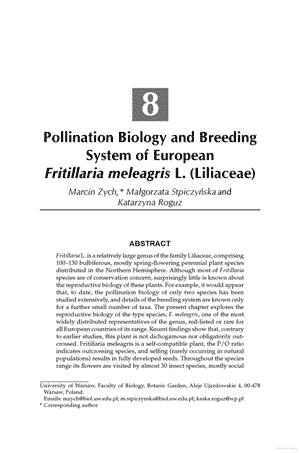NEWS 2014
Pollination Biology and Breeding System of European Fritillaria meleagris L. (Liliaceae)
Marcin ZYCH, Małgorzata STPICZYNSKA, Katarzyna ROGUZ
Reproductive Biology of Plants, CRC Press 8: 147-163 (2014)
http://www.crcpress.com/
University of Warsaw, Faculty of Biology, Botanic Garden, Aleje Ujazdowskie 4, 00-478 Warsaw, Poland
Abstract
Fritillaria L. is a relatively large genus of the family Liliaceae, comprising 100-130 bulbiferous, mostly spring-flowering perennial plant species distributed in the Northern Hemisphere. Although most Fritillaria species are of conservation concern, surprisingly little is known about the reproductive biology of these plants. For example, it would appear that, to date, the pollination biology of only two species has been studied extensively, and details of the breeding system are known only for a further small number of taxa. The present chapter explores the reproductive biology of the type species, F. meleagris, one of the most widely distributed representatives of the genus, red-listed or rare for all European countries of its range. Recent findings show that, contrary to earlier studies, this plant is not dichogamous nor obligatorily out crossed. Fritillaria meleagris is a self-compatible plant, the P/O ratio indicates outcrossing species, and selfing (rarely occurring in natural populations) result in fully developed seeds. Throughout the species range its flowers are visited by almost 30 insect species, mostly social and solitary bees. The main reward for pollinators is pollen and nectar. The latter is produced by six perigonal nectaries and presented to pollinators throughout the flowering period of an individual flower. The maximum nectar secretion overlaps with that of maximum pollen presentation and stigmatic receptivity, and the nectar is resorbed at the final stages of flowering. The nectar composition is composed of sucrose, glucose and fructose in approximately equal quantities and this composition does not change significantly during subsequent stages of flowering. In natural populations F. meleagris is not pollen limited. Although the largest recorded pollen loads are transferred by small pollen-collecting solitary bees, there are no significant differences in pollen deposition and removal among the key floral visitors. However, due to their abundance on flowers, seasonal and floral constancy and tolerance of bad weather conditions, the key pollinators of F. meleagris are bumblebees (mostly of the most common species Bombus terrestris and B. lapidarius). All available literature suggests that the current decline of F. meleagris seems not to be caused by species’ pollination or breeding systems but by the plant’s habitat loss. However, ex situ experiments suggest that smaller populations may be prone to pollen-limitation and, in such cases, the plant species’ dependence on generally rare pollinators and largely out-crossed breeding systems may prompt local extinctions of the species.

